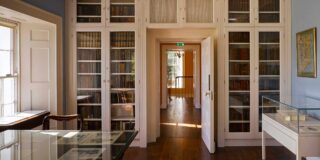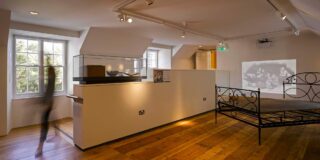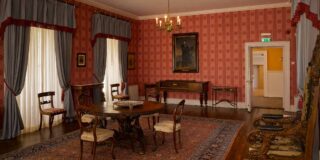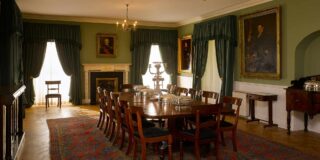Introduction
Derrynane House is the ancestral home of Daniel O’Connell, the 18th century MP for Clare and champion for Catholic emancipation. Today, the house and the surrounding National Park are managed by the Historic Properties division of the Office of Public Works, and are open to the public between April and October each year. The house contains many artefacts associated with Daniel O’Connell and his family, including a family portrait collection, and much original furniture. Four main rooms are open to the public: the dining room and study on the ground floor, and the drawing room and library on the upper floor, as well a coach house which accommodates the chariot constructed for O’Connell’s triumphal return home following his release from Richmond Prison in 1844. Visitors can also visit a small theatre with an audio-visual presentation on O’Connell’s life, as well as the tea rooms; and many use the house as a base for exploring the historic gardens, the wider National Park, and the adjacent beaches and coastline.

Project background and objectives
Historically, a number of issues had been identified in relation to the accessibility of the site, with access for people with impaired mobility limited to the ground floor of the house, and many facilities, including the reception area, restricted in size. There was also stepped access into the audio-visual room, and into the main visitor toilets. Externally, the courtyard surface of grass and crazy paving presented further difficulties to less able bodied visitors.
Until 2006, part of the existing house was used as a caretaker’s apartment, and when this became vacant, the opportunity arose to revise visitor access and extend accommodation into this part of the house. The main project objectives focussed on accessibility: both the physical accessibility of the house and site, as well as increased accessibility of the collections, through enhanced presentation and interpretation.



Description of works
A new accessible visitor entrance and reception space was located in the area previously used as the guides’ room and former caretaker’s living quarters. This space also provides a new internal link to the audio visual room, and gives access to the new lift and stairwell whereby visitors can reach a new exhibition space at first floor, and also visit, via a ramp, the existing drawing room and library, formerly only accessible by the existing stairs. This brings the first floor into use by people with wheelchairs or buggies for the first time. Existing doors and floors, as well as emergency lighting and alarm systems throughout the buildings, were upgraded to meet current fire safety standards.
A new exhibition concept presents the material in a more accessible way, and to a wider audience, including new exhibition cases, multi lingual exhibition texts and guidebooks, and an induction loop facility for visitors with hearing impairments. The house and its collections can now be seen to their best advantage, with a coherent narrative allowing visitors to learn about Derrynane and Daniel O’ Connell in an engaging and authentic manner.
Externally, the surfaces of both the entrance courtyard and the tea room courtyard were re-laid using a mix of stone paving and an accessible permeable gravel surface. Two universal car park spaces and a drop off area were also provided, and levels adjusted to provide level access to all external doors. Where required, external doors have been increased in width to accommodate wheelchairs.


Design approach
There was a limited amount of new work carried out, with a focus on minimising intervention to the protected structure, and re-using, or re-inhabiting existing spaces. Internally, existing structure, fabric and finishes were retained wherever possible, and new materials and finishes chosen to complement these. Floor finishes, where new, are limestone and oak boarding. There was an emphasis on high quality joinery and studwork inserted within the existing building shell, like a finely crafted jewellery box, with integrated seating and exhibition areas.
The approach to the works conformed with best conservation practice and was guided by the principles of minimum intervention, repairing like with like, and the reversibility, where possible, of new intervention works.
The works were partfunded by Fáilte Ireland, and designed and project managed by the architectural, engineering, quantity surveying, and project management teams of the Office of Public Works, assisted by our colleagues in OPW Heritage Services (Historic Properties and Visitor Services). Construction was carried out by Tralee-based building contractors Eamonn Costello (Kerry) Ltd., and completed in May 2014 for the summer season.

